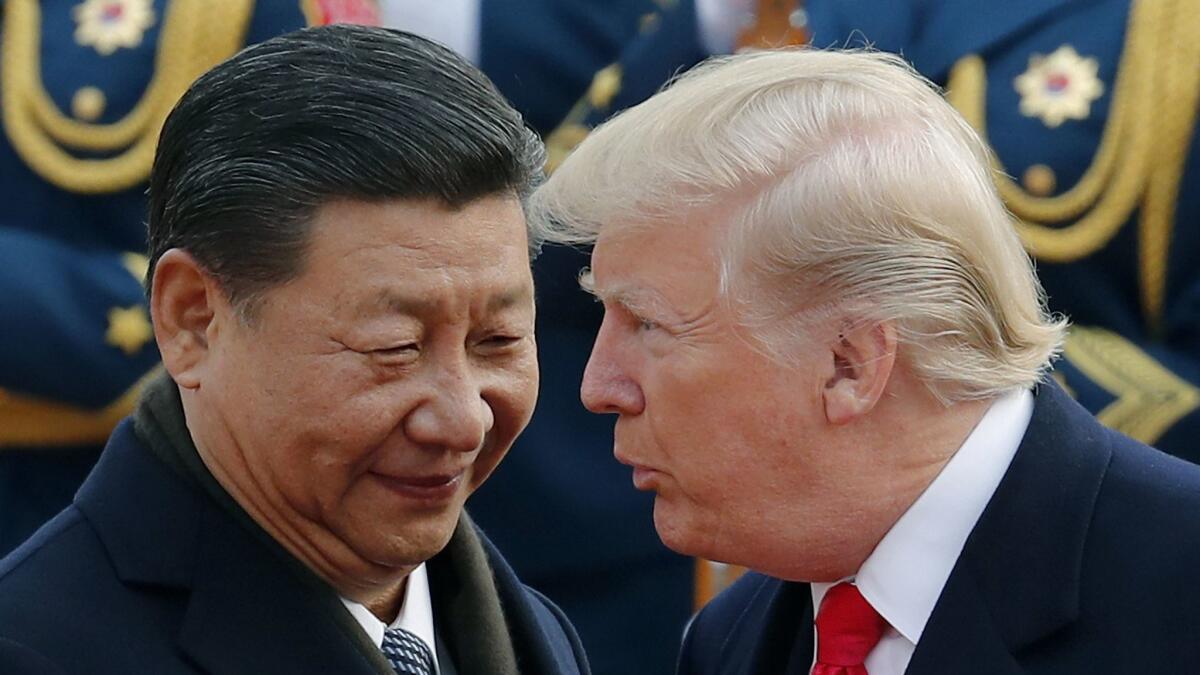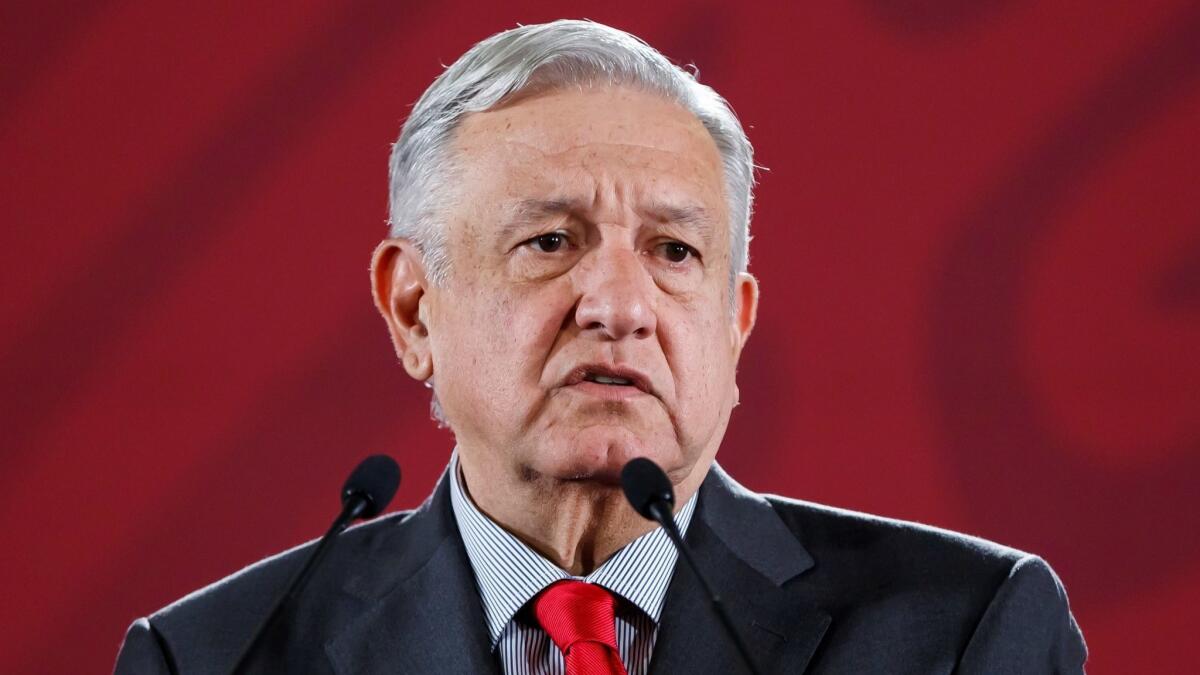China’s lessons for Mexico on Trump’s trade war: Dig in and keep it personal

- Share via
As Mexico faces the prospect of a protracted trade struggle with President Trump, China has lessons to offer its fellow Group of 20 member.
For the last 2½ years, Beijing has witnessed multiple false dawns in its trade standoff with the U.S., enduring a roller-coaster ride of grand announcements, presidential tweets, stalled talks and mutual recriminations. After negotiations fell apart last month, Trump hiked tariffs on $200 billion in Chinese goods to 25% from 10% and stepped up moves to kneecap Chinese companies like Huawei Technologies Co.
Now Mexico finds itself in a similar situation. Shortly after talks with the U.S. were concluded on the replacement for the North American Free Trade Agreement, Trump announced a 5% tariff on goods from Mexico starting Monday unless “decisive measures” were taken to halt the flow of migrants to the U.S.-Mexico border. The president, who on Thursday urged Mexico to “step up,” is holding out the threat of raising the tariffs to 25% by October.
With China and Mexico both facing mounting economic damage, the first lesson, according to Jorge Guajardo, Mexico’s former ambassador in Beijing, is that Trump sees tariffs as the source of his leverage. That means persuading him to remove them will be hard.
“Once he puts the tariffs on, they are there to stay,” Guajardo said. “The idea that he’ll ever lift them is a mirage.” The U.S.’ refusal to immediately remove tariffs was a key sticking point for the Chinese before negotiations broke down.
Liu He kept coming to Washington and talking as if it was going to lead somewhere. It was never going to lead anywhere.
— Jorge Guajardo, Mexico’s former ambassador in Beijing
Presidential intervention
Another key takeaway, according to the Chinese side, is that working-level talks will only take you so far. One Chinese trade official said discussions with the U.S. had reached a point where no further progress could be made without the intervention of the two presidents.
“Liu He kept coming to Washington and talking as if it was going to lead somewhere,” said Guajardo of President Xi Jinping’s trade czar. “It was never going to lead anywhere.”
The U.S. and Chinese sides haven’t met since the world’s two largest economies reached an impasse in their negotiations in May. Treasury Secretary Steven T. Mnuchin will attend the G-20 finance ministers’ meeting that begins Saturday in Fukuoka, Japan, while Trump and Xi will have a chance to catch up at the G-20 leaders’ summit in Japan later this month. Either occasion could provide opportunities for talks to restart.
It’s not quite so easy for Mexican President Andres Manuel Lopez Obrador. AMLO, as he is known, is loath to travel on diplomatic missions and makes a virtue of prioritizing domestic policy. He hasn’t left Mexico in two years, and has already said that he doesn’t plan on attending the G-20.

At the border
As well as sharing a physical border with the U.S., Mexico is more deeply reliant on its northern neighbor economically. Mexico’s exports to the U.S. account for about 80% of its total overseas sales and more than a quarter of the country’s entire economic output. Equally, however, the reciprocal reliance of U.S. exports on the Mexican market may hand AMLO’s administration greater scope for punishing Trump than their Chinese counterparts.
“Exports from the U.S. to China are huge,” said Duncan Wood, director of the Mexico Institute at the Woodrow Wilson International Center for Scholars in Washington. “But exports from the U.S. to Mexico are exponentially bigger, which means Mexico has much greater leverage in what it can hit back on the U.S. with.”
From cars to avocados, consumers could pay the price for Trump’s Mexico tariffs »
Mexico’s $1-trillion output may be dwarfed by China’s $12-trillion GDP, but their shared predicament still highlights the risks that Trump’s trade war has injected into the global economy, including to the U.S. For China, 25% tariffs could result in a drag of nearly 1% on growth by 2021 if they remain in place, according to Bloomberg Economics. The new tariffs on Mexico increase the chances of it entering recession.
Mexico had previously been seen as a potential beneficiary of Trump’s trade conflict with China, as U.S. companies considered shifting supply chains closer to home.
Not any longer. What’s more, the deeply integrated nature of the U.S.’ cross-border supply chains with Mexico mean that it would pay a heavy price for retaliation.

Mexican retaliation
“China can retaliate with blanket tariffs in a way that Mexico cannot because it would be shooting itself in the foot. We would be putting taxes on our own exports,” said Guajardo, the former diplomat. “Mexico will have to be much more strategic in how they impose retaliatory tariffs than China.”
For all their common problems, it’s still unlikely that China and Mexico will work together to overcome Trump’s tariffs. For one thing, the two economies are in competition. For another, there’s something fundamentally different about their long-term relationships with the U.S.
“Mexico has free trade, we’re neighbors, we’ve worked in a complementary fashion with the U.S.,” said Francisco de Rosenzweig, a lawyer at White & Case who previously served as Mexico’s top international trade negotiator. “We’re not in a technology race, nor are we fighting to become the largest economy within a few years.”
More to Read
Inside the business of entertainment
The Wide Shot brings you news, analysis and insights on everything from streaming wars to production — and what it all means for the future.
You may occasionally receive promotional content from the Los Angeles Times.










